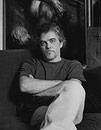Section 1
Section 2
Section 3
A.M.S.: You have painted quite a few series about industrial archaeology in Europe. When did you first take an interest in this subject?
A.P.: Industrial archaeology has interested me ever since I started painting interiors – around 1986, I believe
A.M.S.: That would be about 10 years before your Factory Interiors exhibit in Lecco.
 A.P.: Lecco was an opportunity to collect all my works in a public space. I liked the idea that the exhibition wasn’t simply for commercial motives. Barbara Cattaneo and Oreste Bellinzona first came up with the idea. For a whole year, Mr. Bellinzona came with me while I took pictures of industrial interiors and spaces. In fact, he helped me get permission to get into those places – which wasn’t easy! So it was great because, a part from the painting exhibition, I accumulated a good collection of photos. My interest in industrial archaeology really began a long time before Lecco, with just a few paintings. The exhibition was the reason why I focused on this genre of painting for almost one year. In any case, every time I visited a factory interior, I was amazed. They are fascinating places.
A.P.: Lecco was an opportunity to collect all my works in a public space. I liked the idea that the exhibition wasn’t simply for commercial motives. Barbara Cattaneo and Oreste Bellinzona first came up with the idea. For a whole year, Mr. Bellinzona came with me while I took pictures of industrial interiors and spaces. In fact, he helped me get permission to get into those places – which wasn’t easy! So it was great because, a part from the painting exhibition, I accumulated a good collection of photos. My interest in industrial archaeology really began a long time before Lecco, with just a few paintings. The exhibition was the reason why I focused on this genre of painting for almost one year. In any case, every time I visited a factory interior, I was amazed. They are fascinating places.
A.M.S.: In what way “fascinating”?
A.P.: Fascinating in a pictorial sense, but also emotionally. These places have an influence on you that goes beyond fascination. They are somehow sacred or even mystical, almost like cathedrals. When I enter a large industrial site, I feel myself change on an emotional level. I feel connected to these huge spaces, and at the same time, different from when I first came in.
Perhaps my wish to express this inner change in these paintings was always there, when I first started painting figures in a space. I used to paint figures; then, in about 1986, I started painting interiors and took out the figures. When I went back to painting figures, they were very different, because I was adapting them to the new spaces that I was painting with a wide-angle perspective.
In any case, I needed a strong artistic subject in order to express this inner space with great emotional power. Now I tend to focus on shipyards; back then it was the industrial space. It didn’t matter whether these places were disused or still operating, I never put people in these paintings because I didn’t want my work to be illustrative. You can assume people were once present in these surroundings from the traces they left. However, you won’t find people at work as a subject in my paintings, not now or ever.
A.M.S.: Factory interiors, then, were a vehicle to strongly express your “inner space”, but certainly not the human as a subject. So was there any difference for you between a factory that was closed down and one that was still operating?
 A.P.: Some of these places were still producing. I was able to visit some very old plants that were extremely interesting. Others were cold and sterile like a Swiss clinic – in those places, I had some difficulty finding my subjects, and so I focused on details, such as machinery.
A.P.: Some of these places were still producing. I was able to visit some very old plants that were extremely interesting. Others were cold and sterile like a Swiss clinic – in those places, I had some difficulty finding my subjects, and so I focused on details, such as machinery.
A.M.S.: What struck you in particular about the machinery?
A.P.: Sometimes old machinery has a totemic quality. I saw these huge old abandoned machines, ready to be disposed of or taken away. They looked like sculptures in the cathedral square: but marvellous! What’s more, you don’t understand their function: I have no idea what they were used for, I just saw curves, shapes and gears. I think it’s incredible that there is a style in machinery design: you’d think that they were just supposed to serve their purpose, but they also had a particular form that reflected the time they were built. Since I didn’t know what they had been made for, to me they were just wonderful shapes.
